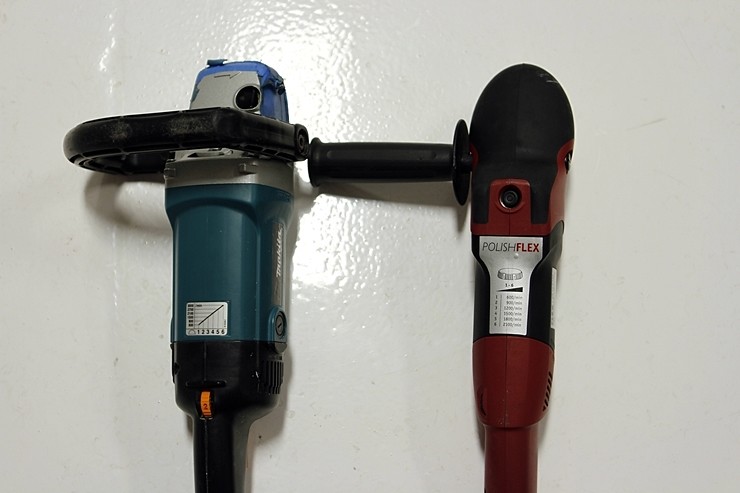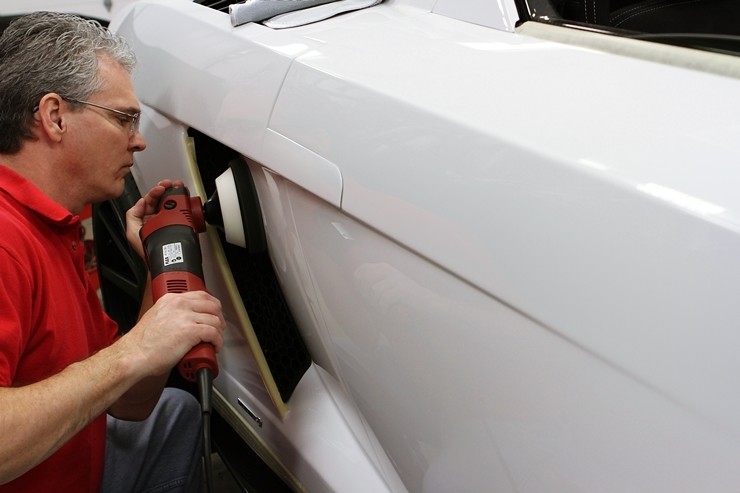Product Review: FLEX PE 14-2 150 Rotary Buffer
by Todd Cooperider
The FLEX PE 14-2 150 Rotary Buffer, also referred to as the POLISHFLEX, is a German engineered and manufactured, professional-grade rotary polisher designed for the automotive detailing and paint correction industry. Most people are aware of their forced rotation DA buffer, the XC 3401 VRG which combined elements of the random orbital with a rotary, but not as many are familiar with their newer rotary model. Could overlooking the PE 14-2 150 as just “another” rotary on the market be a mistake?
As a long time user of the Makita 9227c rotary, I have to admit that I was a bit skeptical when the new FLEX rotary was announced and I saw it for the first time at the SEMA show in 2010. Sure it was smaller and lighter, but at $170 more than the industry-standard Makita, I just didn’t see the value in it. Normally I don’t have an issue with costs if the product works better, more efficiently, or faster (especially on tools). But with a rotary polisher, it simply spins around so how could it be that much different or better?
Fast forward to a year later, and I had been exchanging some emails with the director of FLEX North America when he was giving me a hard time (all in fun, of course) about the banner logo on my personal blog as it shows me using a Makita. OK, for blatant self-promotional reasons I have included that banner image:
Pretty cool, right? OK, back on topic…
So at SEMA 2011, I spent some time talking with FLEX, and we agreed that I would try out their rotary. Shortly after I returned from Las Vegas, a package arrived and it was time to do some testing.
FLEX PE 14-2 150 Rotary: Initial Impressions
When I opened the box and removed the rotary from the packing, I immediately noticed the weight…or lack thereof. The main body was also much slimmer than what I was used to as well. The grip felt good, it was well balanced, and I liked the rubber grip at the front end of the buffer too. Alright then, so it feels good in my hand. That still doesn’t make it worth $170 more than the Makita. I was also very used to the bail handle of the Makita, and the FLEX only had the side handle. Hmmm, not sure how much I am going to like this! I was already having my doubts.
The next job I had lined up required my normal compounding with the DA, and then finish polishing with the rotary, so I rejected the urge to pick up my Makita, and proceeded to test with the new FLEX. I always go into testing new products and tools as a bit of a skeptic, and this was no exception. After all, it didn’t have a bail handle, so how in the world could I possibly like it, right?
Another part of the FLEX that was different from what I was used to was the positioning of the speed dial. On the Makita, the speed dial is on top of the buffer where you can clearly see what your selection is, and is easy to access with your thumb. On the FLEX however, it is on the left side…still easy to access with your thumb, but you can’t see the dial as well. The dial also doesn’t “click” when you make the adjustments like the Makita does, which forces you to look at the speed dial when making adjustments until you learn what speed you’re at based on the sound of the machine.
After getting past all of that, I proceeded to work with the FLEX in as many conditions as I could and with different sized backing plates and pads. I tried it in tight areas, on large surfaces, on heavy contours (easy to find on exotics!), and everything inbetween.
I try my best not to jump to immediate conclusions upon the first trial because you need a broad sampling of tests to draw valid conclusions. And I was already going into the test with my opinion skewed by pre-drawn conclusions…no bail handle, a hefty price tag, and a speed dial that I didn’t like.
My thoughts on the FLEX PE 14-2 150 Rotary Buffer
Well, I have to admit that my aforementioned pre-drawn conclusions were made from an incomplete analysis of facts!
When I used the FLEX, it was like comparing the handling and feel of a BMW M3 (FLEX) to a Ford Crown Victoria (Makita)! Sure the Crown Vic is workmanlike, solid, and more than gets the job done, but everything about the M3 just feels right and it does it with so much more efficiency.
Now if you’re talking about horizontal flat surfaces, you’re not going to notice much difference between the two machines. They’re smooth, they cut well, and they’re easy to handle. But when you get into vertical surfaces, contours, and tight areas, that’s where the FLEX excels by comparison. It’s in the balance, it’s in the small feel of the machine, and it’s the 20% reduction in weight…all of those add up to a significant improvement in “handling”. There just seems to be so much more precision in the feel and handling of the FLEX when you’re working all areas of the car. When I go back to my M3 vs Crown Vic analogy, it’s actually quite similar. On the open road, you won’t notice much difference. But get them into the twisties and more challenging driving conditions, and the weight, the suspension, and the engineering of the M3 just takes the handling to a new level.
And what about my concerns with the bail handle? Well, I adopted to the side handle so quickly that I soon forgot about it. It was a non-issue and was just more of me being a Prima Donna than anything else. By not having the large bail handle attached, it also allowed me to get into tighter areas that I wouldn’t have been able to access without having to take out the tools and removing it. The photo below is a good example of how easy it is to get the small FLEX into tight areas.

And speaking of ergonomics, I really like the addition of the rubber extended handle at the front of the FLEX. When working in tight areas, you may need to (quickly) remove the side handle, and then you can easily maneuver the rotary by holding on to this rubber grip. It feels nice in your hands, and you have a lot of control over it. When you need to apply a lot of pressure for heavy cutting (compounding with wool, for instance), you simply work the machine by holding it at the end and pushing down to give you an even distribution of weight.
With the decrease in weight, good ergonomics, and great handling, it all results in much less stress and fatigue at the end of a long day of buffing. A 20% reduction in weight might not seem huge, but it definitely is after a full day of work.
Another feature of the tool that I really like is the speed range at which it operates. In the interest of modern and responsible buffing techniques, it has a variable speed from all the way down to 600, to a max limit of 2100 rpm. Quite frankly, I don’t think it even needs to go as high as 2100, but at least it’s a step in the right direction. In most cases speed and heat are enemies of proper and safe buffing techniques…not friends! Most of the work that I do and teach are in the 900-1200 rpm range, and it’s also the range at what most of the highline detailers I network with around the world use. With the modern polish and pad technologies out there, you no longer need to “crank it up”. And by keeping the speeds down, you’re also keeping the temperatures down to a safe range (which is another article all in itself!).
Before I get into my final thoughts, I wanted to share a few random photos I snapped during the 6 month evaluation period.
In this photo, you can clearly see how much slimmer the FLEX is than the Makita.

And while this photo may look like the FLEX is bigger, it’s not…just the perspective. I wanted to include this simply so you could see the shape differs between the two polishers.

Here’s another example of getting the FLEX into tight or confined areas.

Final Thoughts
At this point I think it’s easy to tell that I fully endorse and support the FLEX PE 14-2 150 Rotary Buffer, and that most of my initial concerns and pre-drawn conclusions were wrong. Since the very first day that I picked it up and began to use it, I haven’t touched my Makita other than to do some side by side comparisons. The lightweight and the handling of the FLEX simply made it fun to use the rotary all over again.
Does the performance difference of the FLEX make the Makita, or any other rotary buffer obsolete? Absolutely not. The Makita has been a standard in the industry for a long time for many reasons, and it will remain a viable tool. If you’re on a tight budget, then I’d still highly recommend the Makita. But if you can spring for the extra $170 (price of the FLEX at the time of this article is $389), it will be well worth it in my opinion and you’ll never second guess the extra expense.
If I could change one thing about the FLEX it would be the speed dial. For me at least, I’d really like to see a dial that provides fixed speed increments by click. So for instance when you felt and heard a click when adjusting the speed, you knew you were making a change of 150 rpm (or whatever the increment happened to be). So if I wanted to make a jump from 900 rpm to 1200 rpm, I would just need to adjust up 2 clicks, and I would know that I am on an exact speed without having to look down at the speed dial. Over time I have become accustomed to the sound of the machine and can make adjustments without always having to look down, but that doesn’t work if you’re using hearing protection or listening to music while you work. This isn’t a deal-breaker by any means because other than that I absolutely love this machine. But if I could have the perfect machine, that feature would be added.
Whether you’re a seasoned professional detailer, or somebody ready to take the step to a rotary polisher, I couldn’t recommend this more! The FLEX PE 14-2 150 Rotary Buffer is a highly refined and balanced machine, and in my opinion it is worth every penny.
As always, thank you for reading my review, and feel free to leave any comments or questions below.










great article. i love my flex and find i use this one rotary a lot now that i am comfortable with it. the old makitas and de walts are just too heavy. as an older detailer with arthritis this weight savings is vital. the end product of all this is a much better finish and happier customers. thanks todd for the article
Thanks David. I’m not getting any younger myself, and the reduced strain on the body is definitely a positive!
Great review bud. I haven’t been using the rotary enough to warrant a step up from the Makita but will surely keep this in mind for when I upgrade sometime this year.
Thanks Ivan. When you come over to help with one of the classes this year you can try it out if you don’t have one of your own by that time.
Great article Todd. You have described the flex tool in detail. l hope to have a chance at using one, to test it out.Im currently using another brand because at the end of a long day, you want something lighter and dependable. Thankyou.
Thanks Mark, and you’re welcome!
Great review Todd. I’ve been on the fence about the PE 14-2 150, but I think this article has pushed me over. I’ve always disliked my makita on vertical panels due to weight and comfort. This seams to be the item I’ve been looking for!
Thanks again,
Alex
Thanks Alex…you’ll really like this machine!
how would you compare this to the previous model the 3401 which i have an happy with. is it enough of a difference to upgrade to the newer model and what differences do you find. thanks
Robert,
I haven’t used the previous model, and can’t make a direct comparison of the two…
Thanks Todd, nice review. Question: Is the Flex noisier than the Makita? I usually wear hearing protection on an all-day job and was curious. Really like the lighter idea though, that’s a big payoff.
George…thanks. I planned on breaking out the SPL meter to take noise level readings of both machines, but never got the opportunity to incorporate that into my testing. I’d say that their pretty close, with the Makita being just a little bit louder in my opinion.
Todd,
Great article as always! You are tops in giving great info. I also use a Makita, and I also use a FLEX XC 3401 VRG. Any time table for when you might get your hands on the FLEX DA?
Diego…thanks! Hard to say on that one. I’ve tried another brand of forced rotation DA machine, and didn’t care much for it. Having said that though, I should probably give the Flex the benefit of the doubt and take it for a test drive.
Great article, Todd! I use the previous model and love it. This is next one my list of tools to get.
Good evening Todd. Last November I bought a Porta Cable 7420 XP and have been using Lake Country 6 1/2″ foam pads.This has been the best thing since sliced bread. My car and truck have never looked better. I have been thinking about buying some 4 ” pads for the 7420 to get into tight places and to do my motorcycles. The old I get, the less hand work I like. do you think this is the way I should go or should I spent the extra money and get the Flex buffer with 3 or 4 ” pads.
Thanks, Bruce
Bruce,
If you’ve been happy with your results on the Porter Cable, then stick with that one and invest in 4″ pads and the proper backing plate. This setup should suit you well for your needs.
Todd,
This is actually my first post on your site. Thank you for putting up this review. I’m brand new to rotary buffers…I picked up the Flex PE 14-2 at the beginning of the year and finally used it for the first time for polishing out my dad’s ride for his birthday. Previously I used the PC7424XP and although it did the job, it got old REAL quick….or as BB King said…”The thrill is gone…” Thats not to say its a bad buffer…its an excellent tool…I just wanted more out of a machine. When I used my Flex for the very first time, it was like love at first buff. From the sound of the machine when you first turn it on, to the ease of its use. My true test will be to use it on my soft Acura paint. I used it on my dad’s Chrysler 300c which seemed to be very hard paint.
The Flex made polishing fun!!!…I was highly impressed and very excited to use it, and the more I used it, the more comfortable I got with it. It takes some getting used to, but IMO its pretty beginner friendly -especially for a rotary. I share the same and only gripe with you in regards to the speed dial. I wish it atleast clicked. Overtime I’m sure I’ll be able to guess the speed setting by the sound of the machine.
Thanks again for putting this together!
Todd
Nice review of the FLEX.
You ought to test the new BUFFPRO Drum Polisher and give an analysis.
Interested?
Regards
Bud Abraham
How safe is the Flex compared to the PC7424. I too am getting older and a lighter machine would be welcome. I am getting more business due to my attention to detail but at 68 the old bod is not as good as it used to be. My passion is making cars look fantastic and it looks like the Flex is the next level up from the Porter.
Well you’re comparing a rotary to a D/A so you have more “safety” with the D/A than you do a rotary. And the Porter (XP version) is about .25 lb lighter than the Flex rotary. The Flex D/A is a forced rotation, so it gives you benefits of the D/A and the rotary, is safer than the rotary, and will have a better cut than the Porter. It is still heavier though so there’s a price to pay for the increased performance. I hope this helps.
Hello Todd,
Your write pushed be over the edge to purchase the Flex PE 14-2. The question I have is the once I started using it, the surface of the paint became very warm. Is this heat caused by lack of compound and the pads being too dry? If not, what else would cause the paint surface to be so warm?
Regards,
Howard
Todd,
Just bought the Flex and love it. Was wondering if you had a preference between the Flex or the Rupes? I was thinking of adding one of those to my arsenal as well, but they seem to be the same thing just different makes. Ex: Makita/Dewalt. Your thoughts, as I believe you have both or at least used both.
Thanks
Todd,
Great review, and I appreciate your honesty. I’ve used the Makita for a very long time, and would love to move over to the Flex. My concern would be the torque of the Flex compared to the Makita just from my visual perception of looking at the two machines, as the Flex is obviously smaller. I don’t use it in the auto detailing industry, and my profession requires a great deal of torque, not just speed. How would you describe the difference in the torque of the Makita vs. the Flex? I really like how the Makita performs under a load.
Thanks!